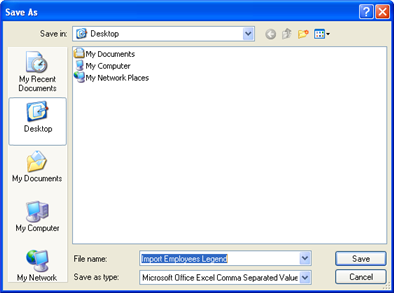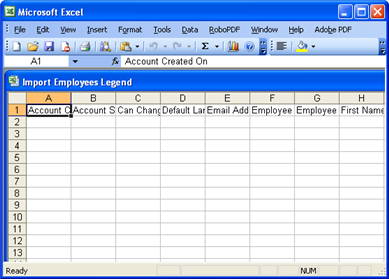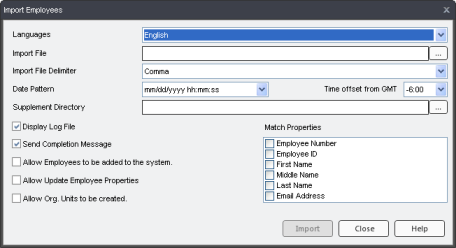
|
|
|
|
Importing Employees can either be completed immediately or can be set up as a Timed Event. If you are accessing this procedure from the Event procedure, you have likely already configured your import spreadsheet. If this is the case, proceed to step 2 of Import Employees procedure. If you have not configured your import information, start at the beginning.
Click here to access a CSV file containing the relevant Import Employees fields. The File Download dialog appears.

Click Save. The Save As dialog appears.
Please note: Do NOT click Open. If you do, the file will open in the Help window, with no way to save any changes you may wish to make.

Navigate to a desired location.
(optional) Enter a new name for the import employees file.
Click OK. The Download Complete dialog appears.

Click Open. The CSV file opens in Microsoft Excel.

Highlight the columns in the Microsoft Excel file.
Place your cursor at the border between the last two columns.
Double-click to make the columns the width of the column names.
Depending on the type of Employee Property you wish to include in the Import, create the corresponding custom property. Select from one of the following procedures to create your property:
Copy the information in the columns of the exported file, and place the information in the corresponding columns of the CSV Import Employees template.
For any custom properties, enter the column header with the same name as was entered as a custom property in TRACCESS CI.
The information for one Employee occupies one row of the spreadsheet.
Select File/ Save As from the main menu.
The Save As dialog appears.
Navigate to an appropriate location.
In the Save As type field, select Unicode text.
The import will also accept other file types such as .txt, .csv, .xls. However, if you wish to import any special characters (such as accents or unicode), selecting Unicode text is the only format that will import the information properly.
Enter a file name, and click Save.
Select Maintenance > Batch Processing > Import Employees from the Ribbon. The Import Employees dialog appears.

Select a language to import the information from the Languages dropdown menu.
Click the ellipsis button ![]() next to the Import File field.
next to the Import File field.
A standard Open dialog appears.
Navigate to the import file, select it, and click Open.
The file name appears in the Import File field.
Select the file delimiter, Comma or Tab, from the Import File Delimiter dropdown menu. (This must match the format used in your import file.)
Select the Date Pattern that was used in the Import file.
You can choose from dd/mm/yyyy, or mm/dd/yyyy, or yyyy/mm/dd. Microsoft Excel often reformats your dates after entering them into their respective fields. Verify with your import file that you have the correct pattern selected.
Please Note: The main reason for this field is to reconcile dates that could either be dd/mm/yyyy or mm/dd/yyyy. For example, 05/12/2004 could represent May 12 or December 5. Not selecting the appropriate date format may still import your records properly; however, it is advised to check that the formats match, just in case.
Select the Time offset from GMT from the dropdown menu.
(Optional) Click the ellipsis button ![]() next to the Supplement Directory field. A standard Browse for Folder dialog appears.
next to the Supplement Directory field. A standard Browse for Folder dialog appears.
Choose a folder that contains the file(s) indicated in the Picture column in the CSV file. For more info, see Import Employees Legend: Picture.
Click OK.
Choose from the options listed on the left.
Display Log File - Displays the View Import Log dialog, showing the log file information.
Send Completion Message - Sends a copy of the log file to your email.
Allow Employees to be added to the system - This box must be selected to add new employees into the system. If there are employees in your import file who do not exist in the system, they will not be added to the system unless this option is selected.
Allow Update Employee Properties - When this box is selected, properties in your system will be overwritten by the properties in your import file.
Allow Org Units to be created - Allows Org Units to be created and employees to be added to them automatically.
Select the properties you want to match with the current database information from the Match Properties box.
Click Import. One of two dialogs can appear:
If you selected the Display Log File option, the View Import Log will appear. You can copy & paste this information into another document, or if you selected the Send Completion Message option, this information is sent to your email. This log indicates how many records were successfully imported and the total amount of errors and warnings. For more info, visit View Import Log.
Click Close.
-or-
If your did not select the Display Log File option, a dialog will appear indicating whether or not your import was successful.
Click OK.
Note: If you selected the Send Completion Message only, you will see receive the log file information in your email.
Your import is now complete.
|
|
|
|